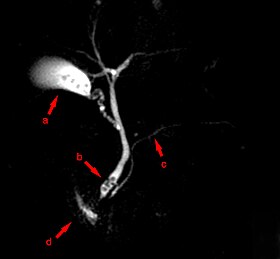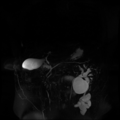Magnetic resonance cholangiopancreatography
| Magnetic resonance cholangiopancreatography | |
|---|---|
 MRCP image showing stones in the distal common bile duct: (a) Gallbladder with stones, (b) Stones in bile duct, (c) Pancreatic duct, (d) Duodenum. | |
| ICD-9-CM | 88.97 |
| MeSH | D049448 |
| OPS-301 code | 3-843 |
Magnetic resonance cholangiopancreatography (MRCP) is a medical imaging technique. It uses magnetic resonance imaging to visualize the biliary and pancreatic ducts non-invasively. This procedure can be used to determine whether gallstones are lodged in any of the ducts surrounding the gallbladder.
Uses[]
MRCP is used to visualize the biliary and pancreatic ducts in a non-invasive manner.[1][2] It is used to diagnose gallstones. It can also diagnose choledochal cysts very reliably.[3] This is useful for visualisation, making other surgeries easier.[3]
Technique[]
MRCP makes use of heavily T2-weighted MRI pulse sequences.[2][4] These sequences show high signal in static or slow moving fluids within the gallbladder, biliary ducts and pancreatic duct, with low signal of surrounding tissue. Secretin is also given to a patient to increase ductal compliance, making imaging easier.[2]
Comparison to other techniques[]
In the diagnosis of pancreatic disorders, MRCP is a much less invasive investigation when compared to endoscopic retrograde cholangiopancreatography (ERCP). Although both techniques can image the ductal system in detail, MRCP also allows imaging of the surrounding parenchyma. In a study from 2008, 269 patients undergoing both ERCP and MRCP showed comparable results between the two techniques.[5]
History[]
It was introduced by Wallner in 1991.[6]
Additional images[]

Benign biliary stricture. 3D File generated from MRCP

3D printed model of benign biliary stricture from MRCP data.

Normal MRCP (with visible renal cyst)
See also[]
Magnetic resonance myelography
References[]
- ^ Prasad, SR; D. Sahani; S. Saini (November 2001). "Clinical applications of magnetic resonance cholangiopancreatography". Journal of Clinical Gastroenterology. 33 (5): 362–6. doi:10.1097/00004836-200111000-00004. PMID 11606850.
- ^ a b c Stevens, Tyler; Freeman, Martin L. (2019-01-01), Chandrasekhara, Vinay; Elmunzer, B. Joseph; Khashab, Mouen A.; Muthusamy, V. Raman (eds.), "57 - Recurrent Acute Pancreatitis", Clinical Gastrointestinal Endoscopy (Third Edition), Philadelphia: Elsevier, pp. 661–673.e3, doi:10.1016/b978-0-323-41509-5.00057-8, ISBN 978-0-323-41509-5, retrieved 2021-01-28
- ^ a b Fulcher, Ann S.; Turner, Mary Ann (2008-01-01), Gore, Richard M.; Levine, Marc S. (eds.), "chapter 77 - Magnetic Resonance Cholangiopancreatography", Textbook of Gastrointestinal Radiology (Third Edition), Philadelphia: W.B. Saunders, pp. 1383–1398, doi:10.1016/b978-1-4160-2332-6.50082-8, ISBN 978-1-4160-2332-6, retrieved 2021-01-28
- ^ Griffin, Nyree; Charles-Edwards, Geoff; Grant, Lee Alexander (2011-09-28). "Magnetic resonance cholangiopancreatography: the ABC of MRCP". Insights into Imaging. 3 (1): 11–21. doi:10.1007/s13244-011-0129-9. ISSN 1869-4101. PMC 3292642. PMID 22695995.
- ^ Hekimoglu K, Ustundag Y, Dusak A, et al. (August 2008). "MRCP vs. ERCP in the evaluation of biliary pathologies: review of current literature". Journal of Digestive Diseases. 9 (3): 162–9. doi:10.1111/j.1751-2980.2008.00339.x. PMID 18956595.
- ^ Albert L. Baert (13 February 2008). Encyclopedia of Diagnostic Imaging. Springer. pp. 123–. ISBN 978-3-540-35278-5. Retrieved 3 July 2011.
- Magnetic resonance imaging
- Digestive system imaging
- Medical equipment stubs


